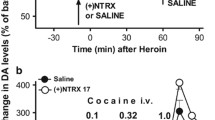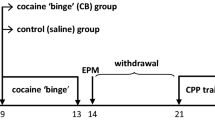Abstract
Rationale
Synthetic psychostimulant abuse, including cathinone-derived 3,4-methylenedioxypyrovalerone (MDPV), continues to increase in many countries. Similar to cocaine but with greater potency, MDPV elicits a transient sympathomimetic response by blocking cellular uptake of dopamine (DA) and norepinephrine (NE)—administration in some users is reported as euphoria-inducing much like cocaine and amphetamine. Pharmacological agents that disrupt excitatory transmission onto midbrain DA-producing neurons, including hypothalamic hypocretin/orexin (hcrt/ox) receptor antagonists, present attractive targets to aide abstinence maintenance by reducing psychostimulant-associated reward and reinforcement.
Objective
The present study sought to assess the degree to which suvorexant, a dual hcrt/ox receptor antagonist, influences drug-taking as well as ultrasonic vocalizations (USVs) associated with MDPV self-administration.
Methods
Rats were trained to self-administer MDPV (~0.03 mg/kg/inf, 3-s) for 14 days under a fixed-ratio 1 schedule of reinforcement, and effects of suvorexant (0, 3, 10, 30 mg/kg, i.p.) on drug-taking was assessed. USVs were recorded during a 30-min pre-lever period as well as during 2-h of MDPV self-administration.
Results
We observed that suvorexant modestly suppressed the number of MDPV infusions earned. Notably, we observed that suvorexant reduced 50-kHz USVs associated with pre- and post-lever time-points but did not noticeably alter call type profiles. Upon comparison of the two measures, we observed trending positive associations between suvorexant-induced changes in drug-taking and 50-kHz USVs.
Conclusions
Results from this exploratory study provide support for the following: (1) studying how suvorexant may provide benefit to humans with stimulant use disorders, (2) identifying a potential role for orexin transmission in cathinone abuse, and (3) further interrogating the potential utility of rat USVs to predict drug consumption in preclinical models of substance use disorders.




Similar content being viewed by others
References
Barker DJ, Simmons SJ, Servilio LC, Bercovicz D, Ma S, Root DH et al (2014) Ultrasonic vocalizations: evidence for an affective opponent process during cocaine self-administration. Psychopharmacology 231(5):909–918
Barker DJ, Simmons SJ, West MO (2015) Ultrasonic vocalizations as a measure of affect in preclinical models of drug abuse: a review of current findings. Curr Neuropharmacol 13(2):193–210
Barros HM, Miczek KA (1996) Withdrawal from oral cocaine in rate: ultrasonic vocalizations and tactile startle. Psychopharmacology 125(4):379–384
Baumann MH, Partilla JS, Lehner KR, Thorndike EB, Hoffman AF, Holy M et al (2013) Powerful cocaine-like actions of 3,4-methylenedioxypyrovalerone (MDPV), a principal constituent of psychoactive ‘bath salts’ products. Neuropsychopharmacology 38(4):552–562
Bentzley BS, Aston-Jones G (2015) Orexin-1 receptor signaling increases motivation for cocaine-associated cues. Eur J Neurosci 41(9):1149–1156
Blanchard RJ, Blanchard DC, Agullana R, Weiss SM (1991) Twenty-two kHz alarm cries to presentation of a predator, by laboratory rats living in visible burrow systems. Physiol Behav 50(5):967–972
Blasiak A, Siwiec M, Grabowiecka A, Blasiak T, Czerw A, Blasiak E et al (2015) Excitatory orexinergic innervation of rat nucleus incertus—implications for ascending arousal, motivation and feeding control. Neuropharmacology 99:432–447
Bonano JS, Glennon RA, De Felice LJ, Banks ML, Negus SS (2014) Abuse-related and abuse-limiting effects of methcathinone and the synthetic “bath salts” cathinone analogs methylenedioxypyrovalerone (MDPV), methylone and mephedrone on intracranial self-stimulation in rats. Psychopharmacology 231(1):199–207
Borgland SL, Chang SJ, Bowers MS, Thompson JL, Vittoz N, Floresco SB et al (2009) Orexin A/hypocretin-1 selectively promotes motivation for positive reinforcers. J Neurosci 29(36):11215–11225
Borgland SL, Taha SA, Sarti F, Fields HL, Bonci A (2006) Orexin A in the VTA is critical for the induction of synaptic plasticity and behavioral sensitization to cocaine. Neuron 49(4):589–601
Boutrel B, Kenny PJ, Specio SE, Martin-Fardon R, Markou A, Koob GF et al (2005) Role for hypocretin in mediating stress-induced reinstatement of cocaine-seeking behavior. Proc Natl Acad Sci U S A 102(52):19168–19173
Brodnik ZD, Bernstein DL, Prince CD, España RA (2015) Hypocretin receptor 1 blockade preferentially reduces high effort responding for cocaine without promoting sleep. Behav Brain Res 291:377–384
Brown RE, Sergeeva O, Eriksson KS, Haas HL (2001) Orexin A excites serotonergic neurons in the dorsal raphe nucleus of the rat. Neuropharmacology 40(3):457–459
Brudzynski SM (1994) Ultrasonic vocalization induced by intracerebral carbachol in rats: localization and a dose-response study. Behav Brain Res 63(2):133–143
Brudzynski SM (2015) Pharmacology of ultrasonic vocalizations in adult rats: significance, call classification and neural substrate. Curr Neuropharmacol 13(2):180–192
Buck CL, Vendruscolo LF, Koob GF, George O (2014) Dopamine D1 and mu-opioid receptor antagonism blocks anticipatory 50 kHz ultrasonic vocalizations induced by palatable food cues in Wistar rats. Psychopharmacology 231(5):929–937
Burgdorf J, Knutson B, Panksepp J, Ikemoto S (2001) Nucleus accumbens amphetamine microinjections unconditionally elicit 50-kHz ultrasonic vocalizations in rats. Behav Neurosci 115(4):940–944
Cornish JL, Kalivas PW (2000) Glutamate transmission in the nucleus accumbens mediates relapse in cocaine addiction. J Neurosci 20(15):RC89
de Lecea L, Kilduff TS, Peyron C, Gao X, Foye PE, Danielson PE et al (1998) The hypocretins: hypothalamus-specific peptides with neuroexcitatory activity. Proc Natl Acad Sci U S A 95(1):322–327
Eriksson KS, Sergeeva O, Brown RE, Haas HL (2001) Orexin/hypocretin excites the histaminergic neurons of the tuberomammillary nucleus. J Neurosci 21(23):9273–9279
España RA, Melchior JR, Roberts DC, Jones SR (2011) Hypocretin 1/orexin A in the ventral tegmental area enhances dopamine responses to cocaine and promotes cocaine self-administration. Psychopharmacology 214(2):415–426
España RA, Oleson EB, Locke JL, Brookshire BR, Roberts DC, Jones SR (2010) The hypocretin-orexin system regulates cocaine self-administration via actions on the mesolimbic dopamine system. Eur J Neurosci 31(2):336–348
Fadel J, Deutch AY (2002) Anatomical substrates of orexin-dopamine interactions: lateral hypothalamic projections to the ventral tegmental area. Neuroscience 111(2):379–387
Flagel SB, Akil H, Robinson TE (2009) Individual differences in the attribution of incentive salience to reward-related cues: Implications for addiction. Neuropharmacology 56 Suppl 1:139–148
Gentile TA, Simmons SJ, Barker DJ, Shaw JK, Espana RA, Muschamp JW (2017) Suvorexant, an orexin/hypocretin receptor antagonist, attenuates motivational and hedonic properties of cocaine. Addict Biol. doi:10.1111/adb.12507
Glennon RA (2014) Bath salts, mephedrone, and methylenedioxypyrovalerone as emerging illicit drugs that will need targeted therapeutic intervention. Adv Pharmacol 69:581–620
Hagan JJ, Leslie RA, Patel S, Evans ML, Wattam TA, Holmes S et al (1999) Orexin A activates locus coeruleus cell firing and increases arousal in the rat. Proc Natl Acad Sci U S A 96(19):10911–10916
Harris GC, Wimmer M, Aston-Jones G (2005) A role for lateral hypothalamic orexin neurons in reward seeking. Nature 437(7058):556–559
Herring WJ, Snyder E, Budd K, Hutzelmann J, Snavely D, Liu K et al (2012) Orexin receptor antagonism for treatment of insomnia: a randomized clinical trial of suvorexant. Neurology 79(23):2265–2274
Hicks C, Gregg RA, Nayak SU, Cannella LA, Schena GJ, Tallarida CS, ..., et al.. Glutamate carboxypeptidase II (GCPII) inhibitor 2-PMPA reduces rewarding effects of the synthetic cathinone MDPV in rats: a role for N-acetylaspartylglutamate (NAAG). Psychopharmacology (Berl) 2017;In Press. 10.1007/s00213-017-4568-y
James MH, Charnley JL, Levi EM, Jones E, Yeoh JW, Smith DW et al (2011) Orexin-1 receptor signalling within the ventral tegmental area, but not the paraventricular thalamus, is critical to regulating cue-induced reinstatement of cocaine-seeking. Int J Neuropsychopharmacol 14(5):684–690
James MH, Mahler SV, Moorman DE, Aston-Jones G (2016) A decade of orexin/hypocretin and addiction: where are we now? Curr Top Behav Neurosci. doi:10.1007/7854_2016_57
Maier EY, Ahrens AM, Ma ST, Schallert T, Duvauchelle CL (2010) Cocaine deprivation effect: cue abstinence over weekends boosts anticipatory 50-kHz ultrasonic vocalizations in rats. Behav Brain Res 214(1):75–79
Marcus JN, Aschkenasi CJ, Lee CE, Chemelli RM, Saper CB, Yanagisawa M et al (2001) Differential expression of orexin receptors 1 and 2 in the rat brain. J Comp Neurol 435(1):6–25
Marusich JA, Antonazzo KR, Wiley JL, Blough BE, Partilla JS, Baumann MH (2014) Pharmacology of novel synthetic stimulants structurally related to the “bath salts” constituent 3,4-methylenedioxypyrovalerone (MDPV). Neuropharmacology 87:206–213
Meyer PJ, Ma ST, Robinson TE (2012) A cocaine cue is more preferred and evokes more frequency-modulated 50-kHz ultrasonic vocalizations in rats prone to attribute incentive salience to a food cue. Psychopharmacology 219(4):999–1009
Muschamp JW, Dominguez JM, Sato SM, Shen RY, Hull EM (2007) A role for hypocretin (orexin) in male sexual behavior. J Neurosci 27(11):2837–2845
Muschamp JW, Hollander JA, Thompson JL, Voren G, Hassinger LC, Onvani S et al (2014) Hypocretin (orexin) facilitates reward by attenuating the antireward effects of its cotransmitter dynorphin in ventral tegmental area. Proc Natl Acad Sci U S A 111(16):E1648–E1655
Mutschler NH, Miczek KA (1998) Withdrawal from i.v. cocaine “binges” in rats: ultrasonic distress calls and startle. Psychopharmacology 135(2):161–168
Nguyen JD, Aarde SM, Cole M, Vandewater SA, Grant Y and Taffe MA. Locomotor stimulant and rewarding effects of inhaling methamphetamine, MDPV, and mephedrone via electronic cigarette-type technology. Neuropsychopharmacology. 2016;In Press. doi:10.1038/npp.2016.88
Nishino S, Ripley B, Overeem S, Lammers GJ, Mignot E (2000) Hypocretin (orexin) deficiency in human narcolepsy. Lancet 355(9197):39–40
Penders TM, Gestring R (2011) Hallucinatory delirium following use of MDPV: “bath salts”. Gen Hosp Psychiatry 33(5):525–526
Peyron C, Tighe DK, van den Pol AN, de Lecea L, Heller HC, Sutcliffe JG et al (1998) Neurons containing hypocretin (orexin) project to multiple neuronal systems. J Neurosci 18(23):9996–10015
Prince CD, Rau AR, Yorgason JT, España RA (2015) Hypocretin/orexin regulation of dopamine signaling and cocaine self-administration is mediated predominantly by hypocretin receptor 1. ACS Chem Neurosci 6(1):138–146
Sakurai T, Amemiya A, Ishii M, Matsuzaki I, Chemelli RM, Tanaka H, ..., et al.. Orexins and orexin receptors: a family of hypothalamic neuropeptides and G protein-coupled receptors that regulate feeding behavior. Cell. 1998;92(5):1 page following 696
Scardochio T, Trujillo-Pisanty I, Conover K, Shizgal P and Clarke PB. The effects of electrical and optical stimulation of midbrain dopaminergic neurons on rat 50-kHz ultrasonic vocalizations. Front Behav Neurosci. 2015;9(331)
Schindler CW, Thorndike EB, Goldberg SR, Lehner KR, Cozzi NV, Brandt SD et al (2016) Reinforcing and neurochemical effects of the “bath salts” constituents 3,4-methylenedioxypyrovalerone (MDPV) and 3,4-methylenedioxy-N-methylcathinone (methylone) in male rats. Psychopharmacology 233(10):1981–1990
Simmons SJ, Gregg RA, Tran FH, Mo L, von Weltin E, Barker DJ, ..., et al.. Comparing rewarding and reinforcing properties between ‘bath salt’ 3,4-methylenedioxypyrovalerone (MDPV) and cocaine using ultrasonic vocalizations in rats. Addict Biol. 2016;In Press. doi:10.1111/adb.12479
Smith RJ, Tahsili-Fahadan P, Aston-Jones G (2010) Orexin/hypocretin is necessary for context-driven cocaine-seeking. Neuropharmacology 58(1):179–184
Spiller HA, Ryan ML, Weston RG, Jansen J (2011) Clinical experience with and analytical confirmation of “bath salts” and “legal highs” (synthetic cathinones) in the United States. Clin Toxicol (Phila) 49(6):499–505
Taylor JO, Urbano CM, Cooper BG (2017) Differential patterns of constant frequency 50 and 22 kHz USV production are related to intensity of negative affective state. Behav Neurosci 131(1):115–126
Thomas DA, Takahashi LK, Barfield RJ (1983) Analysis of ultrasonic vocalizations emitted by intruders during aggressive encounters among rats (Rattus norvegicus). J Comp Psychol 97(3):201–206
Watterson LR, Kufahl PR, Nemirovsky NE, Sewalia K, Grabenauer M, Thomas BF et al (2014) Potent rewarding and reinforcing effects of the synthetic cathinone 3,4-methylenedioxypyrovalerone (MDPV). Addict Biol 19(2):165–174
Wright JM, Dobosiewicz MR, Clarke PB (2013) The role of dopaminergic transmission through D1-like and D2-like receptors in amphetamine-induced rat ultrasonic vocalizations. Psychopharmacology 225(4):853–868
Acknowledgements
The authors acknowledge generous grant monies provided by the National Institute on Drug Abuse (R00 DA031767 awarded to JWM, R01 DA039139 awarded to SMR, Animal Core of P30 DA013429 awarded to Ellen M. Unterwald) for completion of this report.
Author information
Authors and Affiliations
Corresponding author
Ethics declarations
Funding disclosures
The authors have no financial interests to disclose.
Conflict of interest
The authors declare that they have no conflicts of interest.
Rights and permissions
About this article
Cite this article
Simmons, S.J., Martorana, R., Philogene-Khalid, H. et al. Role of hypocretin/orexin receptor blockade on drug-taking and ultrasonic vocalizations (USVs) associated with low-effort self-administration of cathinone-derived 3,4-methylenedioxypyrovalerone (MDPV) in rats. Psychopharmacology 234, 3207–3215 (2017). https://doi.org/10.1007/s00213-017-4709-3
Received:
Accepted:
Published:
Issue Date:
DOI: https://doi.org/10.1007/s00213-017-4709-3




